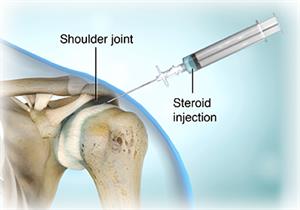Shoulder Tendonitis
What is shoulder tendonitis?
Tendonitis of your shoulder is an inflammation of your rotator cuff or biceps tendon. Your rotator cuff consists of the muscles and tendons in your shoulder. They connect your upper arm bone to your shoulder blade.
Your injury may range from mild inflammation to severe inflammation of most of your rotator cuff. When your rotator cuff tendon becomes inflamed and thickened, it is also called rotator cuff tendonitis. Your rotator cuff tendon may get trapped under the roof, or highest point, of your shoulder. This is called your acromion. It is formed by a part of your shoulder blade, called your scapula.
What causes shoulder tendonitis?
Shoulder tendonitis is usually the result of a tendon being pinched by surrounding structures. Shoulder tendonitis often occurs in certain sports that require your arm to move over your head repeatedly. Such sports include baseball, weightlifting, racket sports, and certain swimming strokes.
What are the symptoms of shoulder tendonitis?
The following are the most common symptoms of shoulder tendonitis. However, you may experience symptoms differently. Symptoms may include:
- Inability to hold your arm in certain positions
- Pain or tenderness in your shoulder
The symptoms of shoulder tendonitis may resemble other conditions or medical problems. Always consult your health care provider for a diagnosis.
How is shoulder tendonitis diagnosed?
In addition to a complete medical history and physical examination, diagnostic procedures for shoulder tendonitis may include:
- X-ray. Invisible electromagnetic energy beams produce images of internal tissues, bones, and organs onto film.
- Magnetic resonance imaging, or MRI. Large magnets and a computer produce detailed images of organs and structures within your body.

- Ultrasonography. High frequency sound waves create an image of some part of the inside of your body.
How is shoulder tendonitis treated?
Your health care provider will determine specific treatment for shoulder tendonitis, based on:
- Your age, overall health, and medical history
- Extent of the condition
- Your tolerance for specific medications, procedures, or therapies
- Expectations for the course of the condition
- Your opinion or preference
Treatment may include:

- Rest
- Nonsteroidal anti-inflammatory medications
- Strengthening exercises
- Ultrasound therapy
- Corticosteroid injection
- Surgery (for severe injuries)
What are the complications of shoulder tendonitis?
If treatment is not started when your pain and discomfort are relatively mild, complications may develop. These may include:
- Pain that interrupts your sleep.
- Loss of strength or motion in your affected arm.
- Difficulty doing things that require moving your injured arm behind your back, such as fastening zippers or buttons.
When should I call my health care provider?
Notify your health care provider if:
- Your pain worsens
- It becomes more difficult to move your injured arm
- Your pain interrupts your sleep
- Your pain and discomfort keep you from doing your normal activities
Key points
Tendonitis of your shoulder is an inflammation of your rotator cuff and/or biceps tendon. It usually results from your tendon being pinched by surrounding structures. You can develop shoulder tendonitis from participating jn certain sports that require the arm to move over the head repeatedly. These sports may include baseball, weightlifting, racket sports, and certain swimming strokes.
Symptoms may include:
- Inability to hold your arm in certain positions, and/or pain or tenderness in your shoulder.
- Diagnosis can be made from a history, physical examination, and using X-ray, MRI, and ultrasonography.
- Treatment may include rest and nonsteroidal anti-inflammatory medications among other things.
Surgery is reserved for severe injuries.
Next steps
Tips to help you get the most from a visit to your health care provider:
- Before your visit, write down questions you want answered.
- Bring someone with you to help you ask questions and remember what your provider tells you.
- At the visit, write down the names of new medicines, treatments, or tests, and any new instructions your provider gives you.
- If you have a follow-up appointment, write down the date, time, and purpose for that visit.
- Know how you can contact your provider if you have questions.
Online Medical Reviewer: Berry, Judith, PhD, APRN
Online Medical Reviewer: Foster, Sara, RN, MPH
Date Last Reviewed: 1/29/2014
© 2000-2016 The StayWell Company, LLC. 780 Township Line Road, Yardley, PA 19067. All rights reserved. This information is not intended as a substitute for professional medical care. Always follow your healthcare professional's instructions.